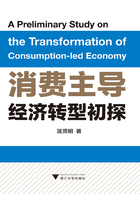
Preface
With the changes of international and domestic development environment, China is gradually losing its traditional comparative advantages.It's hard to sustain economic grow th by investment and export, and it's in urgent need to form a new strategic support.In view of the real conditions, a large market with over 1.3 billion people becomes China's new strategic advantage. To release the potential consumers' demand effectively is of great significance to China's economic new normal.In these years, especially since the eighteenth CPC National Congress, institutional reform and policy adjustment have been sped up to unleash the consumption potential, w hich leads to the relatively rapid growth and structural upgrade of consumption. The domestic market with over 1.3 billion consumers is in the formulation, w hich has brought big changes to the country's consumption structure. For instance, the decade-long decline of household consumption rate and final consumption rate have been controlled and have started to rebound; Consumption's contribution to economic grow th has been increasing steadily; And the third industries directly related to consumption surpassed the second industries for the first time in 2012, becoming the new engine for economic grow th.The spokesman of the National Bureau of Statistic pointed out that although we could not say that China's economic structure has been transformed from the one driven by industry and investment to the one driven by services and consumption, the process of which is speeding up and changes are taking place.
However, compared with this new trend in the economic performance, despite of the abundant research on consumption and grow th, our theoretical research on consumption-driven grow th in the period of economic transformation still lags behind and disagreements still exist on major issues.For example, it is still unknow n whether or not consumption can drive economic grow th and if so, how does it work? In particularly, there is a lack of research on how economic structural upgrade unleashes consumption potential.As a result, we still lack confidence in actively advancing the consumption-led economic consumption and the systematic measures in pushing forward this process.Against this backdrop, conducting research on consumption-led grow th from structural perspective is not only a theoretical proposition, but also a realistic economic problem that urgently needs to be tackled so as to make practical progress in economic transformation in the coming 5 to 10 years.
Based on the review of relevant domestic and foreign research literature, this book explores three ways in which consumption could stimulate economic grow th and analyses the general effect of consumption-grow th with the CD-CG model(Cobb-Douglas production function with Consumption-Grow th). It also explores transitional mechanism for economic drivers in the period of economic transformation by looking into the structural effects of consumption-grow th from the perspective of consumption structural upgrading.
On the basis of historical overview and empirical analysis of urban and rural consumption structural changes, this book puts forward the goals of China's economic transformation.From three aspects of investment-consumption dynamic balance, industry dynamic balance, and government-market dynamic balance, the book makes an analysis to the important problem in unleashing consumption potential. Finally, relative ideas for transformation as the follows are put forward.Firstly, the analysis of consumption structural changes and investment-consumption dynamic balance.By analyzing the status quo of investment and consumption imbalance, the book explores the root causes of this imbalance and then proposes goals and reform recommendations for achieving investment and consumption balance with the structural changes of consumption. Secondly, the analysis of consumption structural changes and industry dynamic balance.By analyzing the internal connection between structural changes of consumption and that of supply and demand, the book explores development trends of the service sectors and proposes reform recommendations for service-sector-led economic transformation that is in line with the changes of consumption structure.Thirdly, the analysis of consumption structural changes and government-market dynamic balance.Through analyzing the internal connection between the release of consumption potential and self-reform of the government, the book discusses the decisive role of market in unleashing consumption potential and puts forward several suggestions.